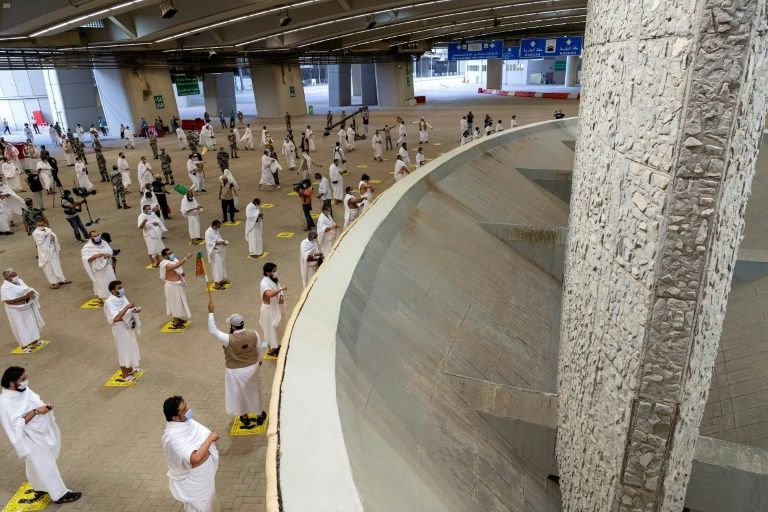Pilgrims stone Satan in last major rite of scaled-back hajj
Muslim pilgrims throw stones at a large pillar symbolising the devil, spaced apart on marked spots to maintain social distancing, in the last major ritual of this year’s scaled back hajj. ©SPA/AFP –
Mina (Saudi Arabia) (AFP) – Muslim pilgrims cast sanitised pebbles Friday as they “stoned the devil” in the last major ritual of the hajj, which the Saudi king acknowledged had been tough to organise amid the coronavirus pandemic.
Massive crowds in previous years triggered deadly stampedes during the ritual, but this year only up to 10,000 Muslims are taking part after millions of international pilgrims were barred.
In the scorching heat, worshippers made their way across Mina Valley near Mecca under the watchful eyes of security forces, to symbolically “humiliate” the devil.
Masked pilgrims, clad in white and spaced apart on marked spots to observe social distancing, threw seven stones each at a wall symbolising Satan.
Instead of gathering the pebbles themselves as in past years, they were handed them bagged and sterilised by hajj authorities, to protect against the novel coronavirus.
Holding the ritual in the shadow of the pandemic required “double efforts” by Saudi authorities, King Salman said, a day after being discharged from hospital following surgery to remove his gall bladder.
“The hajj this year was restricted to a very limited number of people from multiple nationalities, ensuring the ritual was completed despite the difficult circumstances,” said the kingdom’s 84-year-old ruler.
His speech, read out on state television by the acting media minister, came on the occasion of Eid al-Adha, the Muslim festival of sacrifice which began on Friday.
Muslims traditionally slaughter sheep for the three-day holiday in tribute to the Prophet Abraham’s sacrifice of a lamb after God at the last moment spared Ishmael, his son.
Last year, King Salman made the trip to Mina and was seen on state-run television observing worshippers from the window of a high-rise.
But it was unclear whether he would visit this year after his 10-day stay in hospital.
– ‘Dream come true’ –
The hajj, one of the five pillars of Islam and a must for able-bodied Muslims at least once in their lifetime, is usually one of the world’s largest religious gatherings.
But local media said up to 10,000 people already residing in the kingdom are participating this year, compared with 2019’s gathering of some 2.5 million from around the world.
The hajj ministry had initially said around 1,000 pilgrims would be allowed.
On Thursday, pilgrims scaled Mount Arafat for Koran recitals and prayers to atone for their sins in what is seen as the high point of the event.
“I am so happy to be chosen among millions for the hajj this year,” Saudi pilgrim Wedyan Alwah said before setting off on the climb.
“My lifetime dream has come true.”
They made their way down Mount Arafat to Muzdalifah, another holy site, where they spent the night before the stoning ritual.
In previous years, the ritual was not without risk as millions of pilgrims converge on a tight space and the pebbles often miss their mark.
Riyadh faced strong criticism in 2015 when some 2,300 worshippers were crushed, trampled or suffocated in Mina in the deadliest stampede in the gathering’s history.
Authorities have since reinforced safety and security measures.
– Health precautions –
After the stoning ritual, pilgrims returned to the Grand Mosque in Mecca to perform a final “tawaf” or circling of the Kaaba.
The Kaaba, the focal point of Islam, is a cube structure towards which Muslims around the world pray.
The pilgrims, who have all been tested for the virus and are subject to regular temperature checks, are also required to be quarantined after the hajj, authorities said.
Six hospitals, 51 field clinics and 200 ambulances catered to the faithful, health ministry spokesman Mohammad al Abd Al Aly said.
Some 8,000 health care professionals were also deployed, he added.
The hajj began on Wednesday when pilgrims were brought inside the mosque in small batches.
They walked along socially distanced paths marked on the floor, in sharp contrast to the normal sea of humanity that swirls around the Kaaba during hajj.
The hajj typically costs thousands of dollars for pilgrims, who often save for years as well as endure long waiting lists for a chance to attend.
But this year, the Saudi government is covering the expenses of all pilgrims, providing them with meals, hotel accommodation and health care, worshippers said.
Disclaimer: Validity of the above story is for 7 Days from original date of publishing. Source: AFP.


